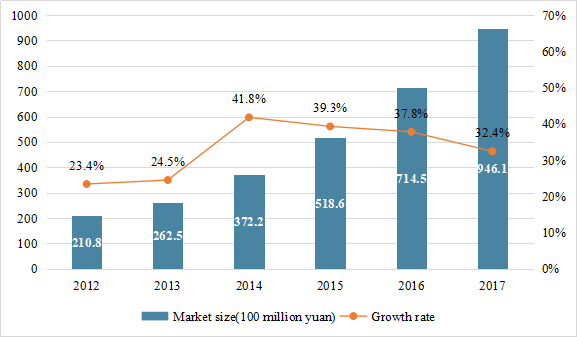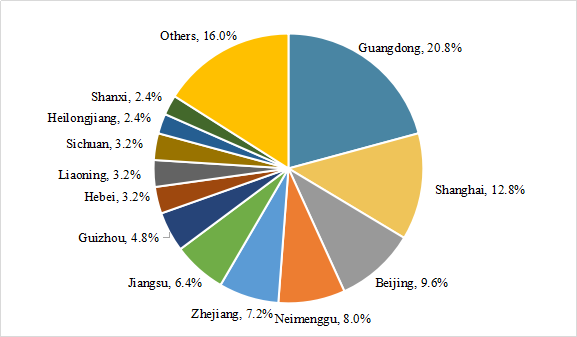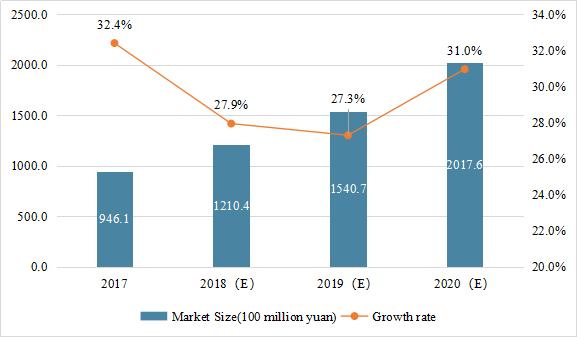Analysis of China IDC market in 2017
Analysis of China IDC market in 2017
Market Size and Development
In 2017 the total size of China IDC market was 94.61 billion yuan, with an annual growth rate of 32.4%. The China IDC market is continuously on the ascent and gradually entering its maturity phase as customers are becoming more aware of their needs so they could evaluate their purchase more accurately. Moreover, IDC service provides are expanding their operation on a constant rate. Market equilibrium could be achieved at different levels in the process of market growth, which indicates China IDC industry is evloving in a professional and regulated fashion.
Strong demand from Internet industry is the powertrain of IDC market growth, with the booming of e-commerce and mobile internet. Moreover, traditional industries are encouraged by policies and digital transformation to enhance their adoption of IT technologies so their demand for IDC services are also on the rise, drving the market growth even further.
Regionally, first tier cities such as Beijing, Shanghai, Guangzhou and Shenzhen are still the leading market with strongest demand for IDC service. These cities combined have accounted for over 30% of the China market and are critical to sustain the growth.
China IDC Market Size (2012-2017)

Data source: IDC Nova, 2018.03
Features of the China IDC Market
Development of large-scale data centers to the regions of lower level of IT adoption
In China the distribution of large-scale data centers is highly correlated with the level of IT adoption in a region. Under normal circumstances, regions with higher level of IT adoption could offer sufficient market demand and resouce readiness, which are the key prerequisite to establish large-scale data centers. However, due to the guidance of local government policies, there are increaingly more large-scale data centers in progress within the regions of lower level of IT adoption.
On the whole, the level of IT adoption in the midwest region of China is lower than that of the more developed regions. However, the development of large-scale data centers has been significantly improved through measures such as investment offerings, policy incentives, and talent management. For areas such as Inner Mongolia and Guizhou, which are majorly supported by state policies, the number of data centers has increased dramatically, attracting both domestic and international Internet giants to show their presence within the region.
(More specific analysis could be viewed in the full version)
Regional Distribution of Large-scale Data Centers

Data source: Ministry of Industry and Information Technology, 2018.03
Competitive Structure of China IDC Market in 2017
Classification of service providers
Based on resource and business model differences, China IDC service providers could be categorized as state-owned telecommunication carriers, carrier-neutral service providers and public cloud based service providers.
State-owned telecommunication carriers: including China Telecom, China Unicom and China Mobile. They have the ownership of massive public infrastructure and were born with enormous advantage of backbone network and international Internet bandwidth. They provide network services and facilities to carrier-neutral service providers, public cloud based servicer providers and industry customers.
Carrier-neutral service providers: including GDS, 21ViaNet, Dr. Peng, Sinnet and so forth. They provide services such as hosting, colocation and data center management. In terms of ownership of data centers carrier-neutral service providers could be subdivided into providers with self-owned data centers and agents who are on leased data centers. The former generally have strong capabilities and resources, mainly targeting at large-scale customers while the latter offer services to a wide range of small-to-medium scale customers.
Public cloud based service (IaaS) providers: including Aliyun, Tencent Cloud, UCloud and so forth. They mainly focus on public cloud services and are usually in a dominant position in vertical markets. Apart from cloud hosting, cloud storage and vertical industry solutions, some of the providers have begun to offer traditional IDC services such as colocation to their customers.
The three types of service providers above are in competition in terms of offering colocation and clouding services while are in corporation in terms of data center leasing and bandwidth purchase.
Analysis on the Advantages and Disadvantages of Different IDC Providers
Provider Classification | Conventional IDC Services | Cloud Services | ||
Advantage | Disadvantage | Advantage | Disadvantage | |
State-owned Telecommunication Carriers | Rich in network and data center resources, strong brand images and competitive prices | Lack of capability to offer value adding services | Ability to achieve the scale of cloud service, advantages in network and sales channels | Poor ability to develop small-to-medium clients due to lack of service flexibility, lengthy R&D Cycle |
Carrier-neutral Service Providers | Flexbile services with BGP connetion and customized business model | Resources constraint from state-owned telecommunication carriers and poor bargaining power | Strong infrustracture operating capabilities and some are innovative in R&D | Insufficient networks and sales channels |
Public Cloud based Service (IaaS) Providers | Strong financial strength to live with intense competition | Lack of self-owned data centers and poor in operation | Advance in vertical technology with strong application capability | None |
Market Trends of China IDC Market through 2018 to 2020
Market Size forecast
China IDC market is entering its maturity phase. It is expected that the market will maintain its growth with a diminishing rate and exceed 120 billion yuan by 2018.
Internet industry, especially e-commerce and streaming branches, will raise their demand for IDC services as their businesses are on track to grow. Traditional industries will accelerate their digitalization process, such as cloud based IT application, which would boost the IDC market even further. In addition, state-owned telecommunication carriers and carrier-neutral service providers will step up their presence in both domestic and oversea markets to continue their expansion of large-scale and hyperscale data centers.
Along with the technological evolution and iteration of application scenarios such as 5G and the Internet of Things, the end-user demand for Internet access will experience explosive growth. Accordingly the application scenario of IDC service will be further expanded and hence trigger incremental demand. It is foreceeable that China IDC market will experience some dramatic growth by 2020, exceeding 200 billion yuan.
China IDC Market Forecast, 2018-2020

Data source: IDC Nova, 2018.03
